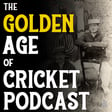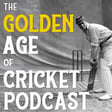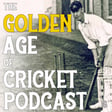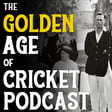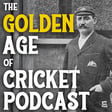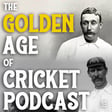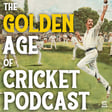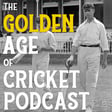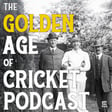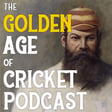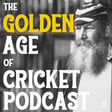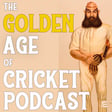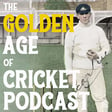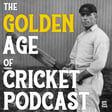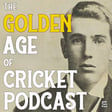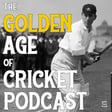Introduction to the Golden Age of Cricket Podcast
00:00:09
Speaker
Hello and welcome to this edition of the Golden Age of Cricket podcast. My name is Tom Ford. Thanks for your company.
Who was Albert Tibbicotta and what was his cricket legacy?
00:00:19
Speaker
Unlike many names from the golden age, that of Albert Tibbicotta is one that is perhaps not revered today with the same nostalgic strain as say a Trumpa, Grace or Ranjit Singhi. Fast bowlers were seen as the graceless, lesser form of Edwardian cricket.
00:00:36
Speaker
the working class necessity compared to their batting counterparts, and Tibby Cotter was certainly that. He was a wayward, fast Australian bowler, both on and off the field, one of the first who purposely chose to frighten batsmen with short pitch deliveries, much to the ire of the English press and fans. His success was achieved through bursts of energy rather than endurance, but proved to be a popular figure with Australian crowds because of his entertaining pluck.
00:01:06
Speaker
As his bowling feet slip further and further from our minds, he is perhaps best remembered today for being the only Australian test cricketer to have made the ultimate sacrifice in the First World War, when he perished in 1917 during the Battle of Bathsheba as a member of the 12th Lighthorse Regiment.
Introducing Max Bonnell, the guest expert
00:01:25
Speaker
My guest today is Max Bonnell, a lawyer and writer from Sydney.
00:01:30
Speaker
He has published around 20 books on sports history and legal topics. He played grade cricket for about 20 years for western suburbs and Sydney University, plus a season in the Birmingham league, as what he describes as a quote, very uncotter-like medium-pacer.
00:01:48
Speaker
Max is a life member of the Sydney University Cricket Club and the Sydney Cricket Association. In 2012, Max co-authored with Andrew Sproul, a biography on today's subject titled Tibby Cotter, Fast Bowler, Larrican, Anzac. And I welcome Max to the podcast as my special guest. Hello, Max. Hello, thank you very much for having me. It's my pleasure.
What inspired Bonnell to write Tibby Cotter's biography?
00:02:15
Speaker
Max, it's fair to say that Tibby Cotter is not the first name which immediately comes to mind when we think of the Golden Age, the so-called Golden Age of Cricket. So what made you turn your attention to him and write his biography? Ah, well the short answer to that is
00:02:41
Speaker
I didn't turn my attention to him. There's a much longer answer, which is that I didn't really think about writing about Kora because to my way of thinking he was a bit too well known. And quite a bit has been written about him in the past, not in a single book, but in stray writings here and there.
00:03:08
Speaker
by people like Jack Pollard. And so I thought the outline of his life was too well known to really require a further examination.
Bonnell's approach to uncovering new historical insights
00:03:22
Speaker
But Andrew Sproul developed an enthusiasm for Cotto's story and did quite a bit of research on it. And then got to the point where I don't think it's unfair to him to say,
00:03:36
Speaker
having gathered a fair amount of material, he didn't quite know what to do with it. And he wanted some assistance shaping it into a book form. And so he was put in touch with me as someone who might be able to help. And I decided to have a look at it. And I thought that perhaps there was more to the story than I had originally thought.
00:04:06
Speaker
So I started adding my own research to his and the book as the result of that. I have a sort of rule in the writing that I do that I won't try to publish anything unless it adds to the record, unless there's something new there that people didn't know before. There are a lot of people who write what passes for sports history who basically
00:04:34
Speaker
rehash and synthesize what's already out there. And whilst there's a place for that, it's not what interests me and I like to find things that are new and unknown. And I think in this one we did enough of that to make it worthwhile.
00:04:52
Speaker
Having read your book, it's very evident that Tibby himself was not a writer. He, I think, left very few letters and certainly, I don't think, kept a diary, which can make it difficult for the biographer.
Challenges in researching Cotter's life
00:05:13
Speaker
So what primary sources were most helpful to you in reconstructing his life?
00:05:21
Speaker
Yeah, well this was a deep frustration because the only words of his own that we have come when he spoke to newspapers, and that didn't happen very often, or in a few postcards he sent home to his family from various tours.
00:05:48
Speaker
you know, they tend to not go very much past having a great time, wish you were here. So he wasn't, words weren't his strong point. He wasn't a writer of any sort. And that's difficult because particularly in this period, the way into a person's character is through
00:06:11
Speaker
the documents he leads behind, the letters, the diaries, and so on. And with Cotto, there was almost nothing. So you're left reconstructing who he was from what he did, rather than from what he said. And that paints a particular picture. But you don't get into the depths of his mind.
00:06:38
Speaker
And one possible reason for that is that they didn't run very deep. He wasn't a very complicated character. As mentioned in my introduction, Tibby is largely remembered today for being the first and one of only two Australian test cricketers.
Myths vs. reality: How did Cotter really die in WWI?
00:07:01
Speaker
I think Ross Gregory is the other one during the Second World War.
00:07:05
Speaker
to have died in an official conflict. We often still today read these terrible analogies between sport and war. Was it important to you as his biographer not to make a martyr of Tibi and to report on his death as accurately as possible?
00:07:30
Speaker
Yeah, I think what we really wanted to do was simply find out what happened because the moment Cotter died, his death and also to some extent his life just became smothered in a layer of mythology because it was compulsory in Australia
00:07:57
Speaker
to present his death as heroic, sacrificial, patriotic. It's very instructive to go back and look at the kinds of things that were written at that time about the war and death in war.
00:08:24
Speaker
And the themes, because you couldn't say anything negative about it. You couldn't say, your son has died. It's a terrible thing. What a waste. You had to say, your son has died. What a glorious sacrifice for the good of his country. What a noble way to die. Because obviously,
00:08:49
Speaker
support for the war effort was considered paramount. And the requirement to maintain morale and support for the war meant that you had to write about deaths in a particular way. Now, what that meant was that it was very difficult to get to the truth about what happened with Qatar, because to get there first, you had to get underneath
00:09:20
Speaker
all the layers of mythology that accumulated over the next 70 to 80 years. Well we're going to return to Tibby's death in greater detail later in the podcast, but first we go all the way back to the beginning.
Exploring Cotter's family and early life in Sydney
00:09:39
Speaker
Albert Cotter was born on the 3rd of December in 1883 in Sydney and he was the sixth and youngest son of parents John and Margaret.
00:09:50
Speaker
Max, what can you tell us about his early life and what, if any, influence cricket played in those early days?
00:10:01
Speaker
Yeah, well his father and I think his mother migrated from England in about 1850. We don't have a precise record of when they arrived and that suggests that they had some means because the records
00:10:27
Speaker
The reliable immigration records that survived from that period are records of what were called assisted passengers who received a government subsidy for migrating to Australia. The fact that they don't show up on that list suggests that they had the means to come out on their own. So not wealthy, but reasonably prosperous, I think.
00:10:57
Speaker
They then set up a butcher's shop in Phillips Street, in the heart of Sydney.
00:11:09
Speaker
shared that building with a confectioner and a milliner. So it was an unlikely combination of sights and smells in the one location. That's where Cotter was born in 1883. He was one of six siblings. There were four brothers.
00:11:37
Speaker
And I think he was about number five of the six. He was one of the younger ones. And the family did well. So at some stage in his childhood, they moved to the suburb of Glebe, which is in the inner west of Sydney. They bought a large block of land, which they actually purchased from the Allen family, who had previously owned that entire area.
00:12:05
Speaker
The Church of England owned another slab of it and the Allens are relevant to cricket because one of the sons Reginald played a test match for Australia in 1887 and Reginald actually signed the contract selling the land to Tibicotta's father.
00:12:30
Speaker
So they grew up in the Glebe, which is an area with lots of parks, lots of open spaces. There's lots of running round. And Tibby starts to play cricket at that point. There's no cricket in the family before that generation. If his father ever played, there's no record of it. But four boys running around in Sydney in the 1880s, 1890s are bound to pick up a cricket bat at some point.
00:12:59
Speaker
Where did the nickname Tibby actually come from? Because from what I understand, having read your book, it's quite unusual for someone to have this name throughout their entire life, certainly with
00:13:15
Speaker
sportsmen, these sorts of nicknames don't materialise until they've entered a sort of professional career.
Where did Cotter's nickname 'Tibby' originate?
00:13:24
Speaker
But Tibby seems to have had it from a very young age. Was it somehow related to his relative short stature? I don't look it. That's the starting assumption, but I don't think it's right. And this troubled me enormously and
00:13:45
Speaker
I spent a disproportionate amount of time trying to find the answer. Tibby doesn't appear in the vernacular anywhere applied to a male. So it's quite common in this period in Scotland, where it's an abbreviation of Elizabeth,
00:14:12
Speaker
or sometimes an abbreviation of Tabitha, and sometimes a vernacular expression for a prostitute. But none of those really seem to fit Tibby. So where does it come from? Look, the way I think of it is this. There was a very good fast bowling all rounder.
00:14:40
Speaker
who played great cricket at the same time I did for Sydney University in Northern District, called Darby Coyle. And his name was not Darby, it was David. But his family, which was even larger than the Cotter family, I think he was one of nine or 10, called him Darby because when he was a child, that was his attempt at saying David. And so he became Darby.
00:15:08
Speaker
And my hunch, which can never be anything more than this, is that that's where Tibby came from. He was called Bertie. He couldn't quite get Bertie out. He said Tibby, and the family started calling him Tibby, and it stuck. Now, that I think is the most plausible explanation, and there's absolutely no evidence for it whatsoever.
00:15:31
Speaker
Well, as his biographer, we'll have to take your word for it. Max, I think you mentioned in your opening answer to this podcast that Tibby wasn't particularly academic, but he went to school in Sydney first to Forest Lodge Public School, where the headmaster of that school was the father
00:16:00
Speaker
of one of his future test mates in Warren Bardsley.
Cotter's education and early cricket achievements
00:16:06
Speaker
What were Tibby's schooling days actually like? Messy is the short answer. Forest Lodge is the local public school near Glee Point Road where Tibby lived as a child.
00:16:28
Speaker
By the time he got there, it was massively overcrowded. In the space of a few years, enrolments shot up from around 400 to over 1,000. And if you look at the Education Department reports on the school from this period, they criticised poor discipline
00:16:54
Speaker
chronic absenteeism, on any day 20% of the students on average didn't turn up. And so William Bardsley, who was the headmaster, who no doubt was a very diligent, hardworking headmaster,
00:17:14
Speaker
was fighting a losing battle with inadequate resources, trying to cope with far too many students. But having said that, they had a very good cricket team. And in the whole period when Cotter was at school there, there's no record of Forest Lodge losing a game to anyone.
00:17:42
Speaker
and typically they bat first and score 150 and then bowl their opponents out for 12. And Cotter returns ridiculous figures like seven for three and six for four and things like that. Warren Bardsley gets most of the runs although Cotter did hit 84 in a school match at one point in very short time. Bear in mind too that
00:18:10
Speaker
at the school but a bit younger and not yet able to get into the cricket team is Charles Kellaway. So three future test players trotting around in the school. Also there is Douglas Mawson, the Antarctic explorer. So it's quite an interesting environment. And Cotter just starts playing school cricket
00:18:35
Speaker
makes a little bit of an impact there, and then naturally gravitates to the local, what would now call a grade club, the Electra Cricket Club of Glebe. And here, Murrumbardsley go down there and start playing in the lower grades. His father decides to put some polish on him, and he sends him to Sydney Grammar School for his last couple of years.
Cotter's ascent to New South Wales cricket prominence
00:19:04
Speaker
And that's an interesting choice because Sydney Grammar School has an academic emphasis. You learn a lot of Latin there. But it also is very serious about its sport. And I think the idea was to put a bit of refinement onto the boy by putting him in a more disciplined
00:19:32
Speaker
genteel environment because grammar is a fee-paying school. So the sons of well-to-do people go there. And he does well to the extent that he plays in the rugby team and he plays in the cricket team. His cricket, he has two seasons there and it's interesting because the master in charge of cricket was a man called George Barber.
00:20:01
Speaker
father of Eric Barber, the New South Wales batsman, who was an approximate contemporary of Cotter. And George Barber is exactly what you would imagine a Latin teacher would be if he became a cricket coach. He wants batsmen to play straight. He wants bowlers to be accurate. He wants boots to be white. He wants everything to be orderly.
00:20:30
Speaker
And Cotter breezes into his team as this gust of disorder. And Barbour doesn't particularly like it. So if you read the reports that Barbour writes on the school matches, they're full of comments like, Cotter will take five for 20.
00:20:55
Speaker
And the comment will be, Cotta's bowling was less wild than usual. So, Cotta is not, the guy who is George Barber's kind of cricketer is a left arm medium pacer called Herbert Allen, who bowls at the stumps and bowls a good length and moves the ball a little bit and does the same thing week in, week out. And the coach likes that.
00:21:23
Speaker
Alan plays a little bit of first grade cricket and then fades into obscurity. But in his second year at grammar, Carter took 110 wickets, which even allowing for the fact that Barbara scheduled a lot of games outside of the school competition matches is a lot. And he was selected to play for the New South Wales second 11 while he was still at school.
00:21:54
Speaker
really on the basis of his performances for Sydney Grammar. He only played five first grade games for Glebe at that point. So again, that's a transition that just doesn't happen anymore. You don't get people picked out of private school cricket in Sydney to play state second 11 games.
00:22:16
Speaker
And that probably achieved most of what the Cotter family expected to achieve from his time at grammar. And he was then pulled out of the school before he needed to sit any exams.
00:22:48
Speaker
and it does seem as you mentioned his sudden appearance for the New South Wales second 11 that his rise to the highest level of international cricket it does seem to have happened very fast after his first class debut for New South Wales which happens in
00:23:12
Speaker
the later stages of the 1901-02 season. He makes his test debut against the famous MCC selected England touring side of 1903-04. Was it as meteoric as all that?
Cotter's transition from grade cricket to Test matches
00:23:32
Speaker
Yeah, it was. He was picked for one game for New South Wales in 1901-02.
00:23:41
Speaker
when Monty Noble was the sole selector for New South Wales. And Noble decided that the side needed some new bowlers. The obvious bowler who should have been picked was the best bowler in New South Wales, who was Jack Marsh. But Noble didn't care for Marsh and wouldn't pick him. So he tried
00:24:11
Speaker
some unusual experiments. One of them was Alex Kermode, who got plucked out of the Moorpark competition to open the bowling for New South Wales. And another was Cotter, who had only played by that stage eight first grade games. Without special distinction, he hadn't done anything very remarkable. His first game was a failure. He was out twice for naught.
00:24:39
Speaker
He didn't take a wicket. He didn't bowl a lot. And he was overlooked the next season. But the problem New South Wales had at that point was that they had too many bowlers who were very similar. You had Noble himself, Bill Howell, Burt Hopkins, who all really bowled slow, medium offspit.
00:25:08
Speaker
Howl spun the ball a bit more than the others. Noble swerved the ball a bit more than the others. But you could still have over after over of slow, medium off-spin. And they needed something a bit different. So in January 1904, Cotter got called up against Victoria.
00:25:29
Speaker
And he did very well. He took four for 50 in the first innings. A couple of wickets in the second made an impact with his speed. Two weeks later, New South Wales played the MCC and he kept his place for that game. And MCC hammered New South Wales mercilessly.
00:25:51
Speaker
They won by 278 runs, but Kotter again made an impact. He took five for 44 in the first innings, three for 56 in the second. Again, his pace disrupted things. Two weeks later, the fourth test of the test series is played. It's in Sydney and Kotter gets picked. So he's gone from playing great cricket with Glebe
00:26:20
Speaker
to being in the test team in four games. And that is, that's quite a dramatic rise. He does all right in his first test. And I should say, yes, it's meteoric, but for the period, not dramatically unusual. And that's because there were only three states in the Sheffield Shield. So only 30-odd potential test prisoners.
00:26:51
Speaker
And the Sheffield Shield was four games a season for each team. So if you got picked halfway through the Sheffield Shield season and did well, you were instantly a test candidate. And this period is full of people like Cotto, like Tom McKibben is another good example, who come out of obscurity, have one really good Shield game or two really good Shield games,
00:27:21
Speaker
there's a test match on the next week and they get picked. So it's rare, but not startlingly rare. Anyway, he does well in the first test. He unexpectedly goes in at number 11 and hits 34 in the second innings. And in the second English innings, he took three for 41. Australia got pandered, but he kept his place for the last test of the season.
00:27:48
Speaker
which was a consolation victory for Australia. They caught England on a wet pitch and cotter bowled them out for 61 to 6 for 40 from not very many overs. And that was quite a remarkable effort because conventional wisdom at the time was that fast bowlers couldn't bowl on wet pitches because they couldn't stand up.
00:28:16
Speaker
a foot slide when they hit the ground. But Cotter by this stage of his life was incredibly strong, really athletic, had phenomenal balance and he was able to maintain his footing in very unhelpful conditions and made life very difficult for the batsman down the other end. So within the space of
00:28:45
Speaker
let's say six weeks, he's gone from being a club bowler on Saturdays to being the spearhead of the Australian test attack.
Highlights from Cotter's 1905 England tour
00:28:57
Speaker
Yeah, it's a success story that we just don't see today in modern cricket. So his success in the 1903-04 Australian season warrant selection for the 1905 tour of England, which is led by Joe Darling, the experienced Australian captain who
00:29:25
Speaker
himself wasn't even guaranteed a spot. He was a rather late selection having been busy farming down in Tasmania. He was then selected as the captain of that tour. The 1905 tour was perhaps the high point of Tibi's international career, both reputationally and statistically.
00:29:48
Speaker
The English press herald him as the new Spofforth, the famous Australian fast bowler known as the Demon, because of his extreme pace. And Tibby ends up taking 121 wickets, first class wickets on tour in 1905, including a spell of seven for 15 against Worcestershire. How do you assess his first tour of England?
00:30:19
Speaker
Well, counterintuitively, I wouldn't rank it as a high point. And I say that for this reason. Early in the tour, he was dreadful. He didn't adjust to the English pitches at all. His pace was fine, but his line and length were all over the place.
00:30:46
Speaker
In the opening game, I forget which side it was against, but it was one of these sorts of teams that the Australians used to encounter on tour a lot in that period, which was a scratch side playing under the name of some titled patron. Lord so-and-so's 11.
00:31:14
Speaker
In the opening game he bowled at WG Grace and hit him in the chest with an unintentional beamer because he really had no idea where the ball was going. He played in the first test at Nottingham and he did quite well in the first innings. He got
00:31:40
Speaker
Stanley Jackson, John Gun and Tom Hayward, he got three for 50 odd, three for 64 maybe, and he was reasonable. But then in the second innings, England piled up five for 426 and he was ineffective. He didn't really get his act together in the county games and he was dropped from the second and third tests.
00:32:10
Speaker
Now, of course, what happens in England is that as the summer goes on, generally, if you're lucky, the pitchers get drier and harder. And it became easier for Cotter to do what he did best. And he started to trouble a lot of the county sides. He absolutely destroyed Worcestershire.
00:32:37
Speaker
Worcestershire, he took seven for 15 in the first innings, but I think there was a burst of seven for three and about three overs at the end. It was pretty dramatic. And then when Worcestershire batted again, they were five for 51 when the game was washed out and Cotta had five for 19.
00:32:58
Speaker
So he had 12 for 34 in the game, which is ridiculous. And if you read the reports of that match, they all say that the batsmen simply didn't try. They were simply terrified and got out of there as soon as they could. So he started to click. He came back for the fourth test. England won by an innings. He took no wickets. And they kept him in the side for the fifth test.
00:33:27
Speaker
And there, he produces what is statistically his best test performance. England runs up 430, but Cotter gets through 40 overs and took 748.
00:33:45
Speaker
So, expensive, but, you know, he's dismissed batsman like McLaren, Tilda's Leaf, Fry, Rhodes, Spooner, some of the great names of English cricket of this period, and he's shown his ability to get through a lot of work. So, you know, it's an outstanding performance, but not a game-changing one. The game fizzles out into a draw.
00:34:14
Speaker
He had, on the 1905 tour, he had some remarkable performances against the counties once the pitches quickened up a bit. But his impact on the test series was negligible.
How did Cotter influence Australia's 1909 Ashes victory?
00:34:28
Speaker
Whereas in 1909, on the tour as a whole, he took 64 wickets at an average of 29. And if you look at that by the standards of the period, it's pretty underwhelming.
00:34:42
Speaker
but I think he was better in 1909, and I'll explain why. Something different happens on that tour. Monty Noble is the captain, and he works out that nobody cares if you draw against Sussex if you win the test series. And no one's ever thought like this before. Everyone's always thought that the team's record is assessed on
00:35:10
Speaker
overall wins and losses. And Noble's point is, well, who cares about the match against Leicestershire? We want to win the test series. And so he doesn't care what Carter does in the county games as long as he had his best in the tests. And so what happens is that the Australians played 37 games, 22 were drawn.
00:35:36
Speaker
So the whole idea of needing to beat the counties was not a priority. It rained a lot, which had something to do with the number of draws. But critically, Australia won the test series 2-1. And whilst Cotter was indifferent in the county games, he was sharp in the tests. So the first test Australia lost,
00:36:03
Speaker
The second, Cotta sets up a win with a burst of four wickets in the first innings. At Leeds, he just demolishes England for 87 in the second innings, takes five for 38. And then the oval test Australia needs to draw to win the series, and Cotta contributes to that by taking six for 95 in the first innings. So over the test series,
00:36:32
Speaker
He takes 17 wickets at 21. He's easily the leading wicket taker for the Australian side. And he contributes materially to the two wins and significantly in the draw in the last test. So I'd actually argue that whilst, if you look at the overall numbers, 1905 looks like the success and 1909 looks like the failure. 1909 is probably the peak of his test career.
00:37:00
Speaker
because there he's the spearhead of a side that wins an Asher series in England. Yeah, that's a really interesting way of looking at it. And perhaps we should give credit to Monty Noble for essentially introducing the modern concept of player management. He obviously knew
00:37:29
Speaker
the that the entire tour would have exhausted Tibby and what I learned reading your book was that Tibby was a player and a bowler who was at his best when he bowled
00:37:44
Speaker
in short bursts. He was not a player that could just bowl and bowl and bowl. I think his pace and his form would drop off and so Monty Noble obviously saw this style in or approach from Tibby and knew that he wanted to save him for the games that mattered most. Yeah and this is a hundred years before anyone's heard of rotation policies.
00:38:12
Speaker
And the Australian teams to England always used to try to take as few players as they could get away with because they were splitting the profits. And you didn't want to split the profits 16 ways if you could get away with splitting them 14 ways. So the burden on players was greater. I mean, Noble's approach outraged
00:38:41
Speaker
the editor of Wisdom who complained that the candy games weren't being treated with the seriousness they deserved. But there was never any putting that genie back in the bottle.
The strategic introduction of the modern slip cordon
00:39:11
Speaker
Well returning to the 1905 series and it was during this tour as well that Joe Darling, the captain of the Australians revolutionised a style of fielding in
00:39:28
Speaker
direct response to what Tibby was sending down as a bowler. It's generally regarded that during this season Darling introduced what we now know as the modern slip cordon.
00:39:43
Speaker
when Tibi was bowling. There's a few photographs that exist of field placings before this tour and you see generally there's probably one, if at all, slips. But it's during this 1905 season that the modern slip cordon is introduced, certainly when Tibi is bowling. Was Tibi a pioneer on the cricket field?
00:40:11
Speaker
Oh, look, I think so, but an accidental one. It's a bit like Columbus discovering the West Indies when he was looking for India. What happened was that, not unlike his school coach, George Barber, Joe Darling got a bit frustrated at the fact that you could never really be sure where coral was going to bowl.
00:40:41
Speaker
And so he decided that the way to focus Cotter on bowling somewhere near the off stump was to remove all the fieldsmen from the lakeside. So he would typically get Cotter bowling to a 7-2 field with someone at fine leg and someone at mid-ong and everyone else on the offside. And what he found when he did that
00:41:08
Speaker
was that if Cotter could bowl consistently somewhere around the off stump, because of his pace, there were a lot of edges. And so he finished up generally with about four men in the slips. And this wasn't something that had typically happened in cricket before. There were obviously slip fieldsmen previously, but the
00:41:37
Speaker
it had always been associated with negative bowling. So for example, Tom Garrett, the medium paiser who played for Australia in the first 10 years of test cricket was regarded as a terribly negative bowler because his strategy was to bowl just outside of stunt with a couple of men in the slips and someone at point and a cover and forced the batsman to
00:42:05
Speaker
play a shot and make a mistake. And this was derided as bowling for catches, as if it were terribly negative and unsportsmanlike. But of course, you've just described how Glenn McGrath bolts. So today, we wouldn't regard it as unusual. But no one had ever really thought before of what they called off theory as an attacking move, as opposed to a negative form of cricket.
00:42:35
Speaker
and yet that's what it became. So the game changes at that point and Kota is an agent of change even if he's not terribly conscious of what he's doing.
Controversy over Cotter's aggressive bowling style
00:42:53
Speaker
Yes, and he does incur the wrath of the English press and fans because of his adoption of repeat short balls to intimidate the opposition batsmen, which was a tactic that was not really employed previously, certainly not to any great effect.
00:43:17
Speaker
And even though it was in the laws of the game, the London referee newspaper, for example, said, and I'm quoting them here, we hope we shall see no more of the monstrous style of bowling adopted by Cotter. To deliberately pitch halfway with no other object than to frighten the batsman by making the ball go over their heads is emphatically not cricket. What was Cotter's response to this?
00:43:49
Speaker
Unapologetic, I think, would be the first place you'd go. There's the legendary story of the earlier Australian fast bowler, Ernie Jones, bowling the ball that goes through WG Grace's beard. And he's supposed to have marched down the pitch and said, sorry, doctor, she slipped. Well, Cotter does not apologize. He never developed a particularly
00:44:17
Speaker
reasoned theory of bowling, but there's no question that he deliberately used the fast short pitched ball as a means of unsettling the batsman. And his special target is John Tildersley, a Lancashire batsman, who has a reputation in England in this period as being a very fine batsman against fast bowling.
00:44:47
Speaker
and Cotter simply terrorised him. He just tildersly would come into bat and the first few balls would be around his ears and he was never, he did get a hundred against Cotter in a test but overall his impact was greatly reduced because Cotter just got under his skin.
00:45:10
Speaker
And this is, again, something that was new to the game because the idea of deliberately intimidatingly bowling was regarded as shockingly unsportsmanlike, but Kotter was untroubled by that.
00:45:30
Speaker
Yes, and this is what I find so fascinating about this period, the so-called Golden Age, is that we have so many of these cricketing conventions that exist during this period, largely in regards to batsmen, amateur batsmen, about how they should be
00:45:52
Speaker
playing a certain stroke and when and which part of the ground and we've certainly heard about this in previous episodes with CB Fry and Ranjit Singhi and
00:46:09
Speaker
And then of course we get these rascally Australians arriving in England and the Australians either are unaware of these conventions or they simply don't care and really challenge the establishment. Warwick Armstrong for one is someone who repeatedly
00:46:30
Speaker
tries to stick it up. The cricketing establishment in England and I would probably place Tibby in that same category as well.
Analyzing Cotter's unique bowling technique
00:46:43
Speaker
Max, let's talk about his actual bowling technique. Your book goes into great detail about
00:46:52
Speaker
his rather unorthodox action. Despite the lack of really any footage, there is a brief bit of footage taken from that 1905 tour. He had a very unique action where, and I'm going to do my best to describe it, where as he approached the wicket in his final leap, his right foot being a right-hander,
00:47:20
Speaker
would actually curl behind his left foot. It looks very unusual just before his final landing at the crease. Is it fair to say it was an unorthodox action? Yeah, and his arm disappears behind his back and it comes out in a sling. And this is why, you know, one of the things that is generally
00:47:47
Speaker
said to be known about Cotter is that he had a slinging action similar to Geoff Thompson's. Now, that's got a little bit of truth in it. And we know a lot about Howie Bold. We know that for two reasons. One is that he was photographed a good deal from various angles by George Beldum, the cricket photographer of the period who
00:48:19
Speaker
published an enormous number of works of photographs of cricketers. He'd set them up in the middle of the field and it wasn't match conditions but they weren't posed photographs, they were action photographs in a posed setting. And of course Max, the most famous photo from that series is the Victor Trumper stepping out to drive. The Victor Trumper jumping out to drive.
00:48:46
Speaker
Yeah, which is not taken in a game, but in that artificial situation. So we've got a lot of those photographs of Cotter and we have two balls from the Nottingham test of 1905. And that's interesting, but you've got to be very careful drawing conclusions about it.
00:49:12
Speaker
You have to be careful for two reasons. One is simply the quality of the film makes it difficult to really know the speed at which things are happening. And it could be a little deceptive in that respect. And the other reason is that at the time that these two balls were bowled,
00:49:34
Speaker
England was five for 420 and about to declare and Cotter was really going through the motions. So he doesn't look particularly terrifying on the two balls of him that we have. What distinguishes him from Geoff Thompson is this. If you recall Thompson at his peep, which is probably
00:50:03
Speaker
the 1974-75 series against England and the series against the West Indians the following year. What made Thompson so difficult was not speed per se, although he was certainly faster than anyone else, but dangerous bounce from a good length. So the ball would just rear up unexpectedly. And the reason for that
00:50:33
Speaker
was that when he bowled his left leg, his front leg, was braced absolutely straight. And that meant two things. One was a much more complete transfer of body weight forward when the arms swung over. And the other was a much higher delivery point, which is where that steepling bounce comes from. Now, what Cotter did
00:51:03
Speaker
was when he got into his delivery stride, his front leg collapses, his left knee bends, and he actually bowled from quite a low position. He was about five foot eight, which is average height, maybe even on the tall side for the time, but it's not the kind of height that of itself is going to generate a lot of bands.
00:51:27
Speaker
and he bowled really from quite a low position. So if you were going to compare slingers, I'd say that he was more a malinga than a Thompson, although the truth is he was somewhere in the middle. His arm was a little bit more
00:51:53
Speaker
vertical than Malinga's, but nowhere near as high as Thompson's. This is Malinga from Sri Lanka of course. Sri Lanka, yeah. Now Malinga was virtually a rounder. His arm was really parallel to the ground. Cottaw was a bit higher than that, but he didn't have that dangerous trajectory that Thompson
00:52:19
Speaker
did have because of that technical flaw in his action of the collapse of the front leg.
Conclusion of Part One on Albert Tibi Cotter
00:52:27
Speaker
Thanks for listening to part one on the life and career of Albert Tibi Cotto with my special guest Max Bunnell. Keep an eye out for part two by subscribing to the podcast now. I'm Tom Ford. Thanks for your company.

